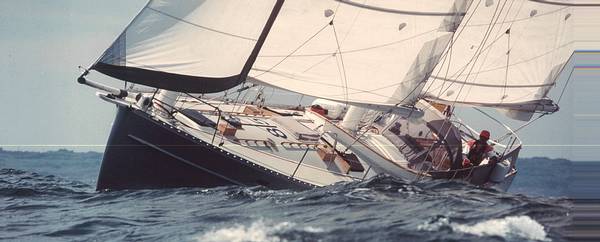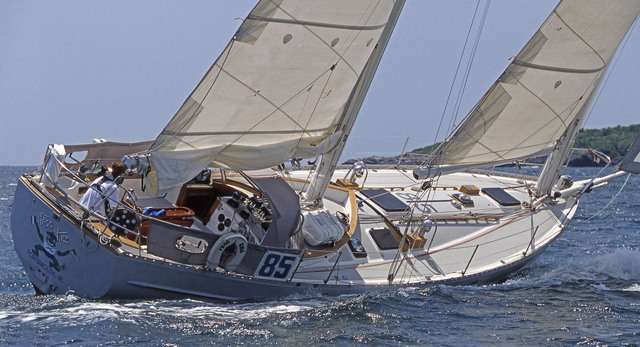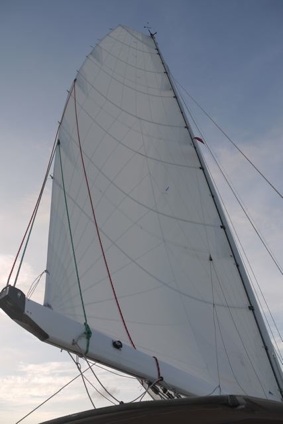I still struggle with too much weatherhelm when sailing a one mast 38ft or 45ft. Weatherhelm is understandable in a one mast design with a large mainsail an relatively small jib.
Beating to windward in 15-20 knot wind I seldomly have less than 15 degrees of rudder; loosing speed and causing a turbulent wake and extra load on the steeringsystem.
Not to mention loss of pleasure, sailing like this is like ‘riding a reluctant horse’: not as much fun as could be possible. Reefing the main, enough to give a nice weatherhelm, reduces the boatspeed so much, almost any other boat is overtaking me. No fun either. Curious to know whether other owners recognize this problem. How do you handle? Anyone find a brilliant solution?
Hans,
I raced a Laser for some years and as you know the come with only a mainsail. Weather helm is severe if the trim is off. Some thoughts here that you perhaps already had yourself, but anyway;
- The first step before reefing is flattening the main. Perhaps there is more you can do to flatten yours.
eg: - do you have a cunninghamhole (flattening reef?) If not, tightening the halyard has the same effect.
- also tighten the foot by tightening the outhaul. I know many sloop sailors never touch their outhauls.
- tighten the boom vang before the sail is filled by the wind.
- how about your batten tension? if they are too tight, they create more depth in the sail when the vang is tight; the round roach becomes a straight line and squeezes the battens against the mast. Reducing the batten tension flattens the sail.
- a last thought: you could use running backstays from the mast head to create some pre-bend in the mast top section, thus opening the leech in the top third of the mainsail.
If you already worked all this over, installing a smaller first reef is perhaps an option.
Michel
1 simple word: Reef
Personally I never do anything less than a double reef. A single reef always adds too much belly to the sail and is almost worse than no reef. With a double reef the boat is well balanced.
– Geoff
Thanks Geoff and Michel,
The reefs in my main arer already deeper than standard. Reefing to have a balanced boat does work but cost a lot of speed which I hope to prevent losing. I have a cunningham lead to a winch on the 38ft. Can’t apply otherwise enough tension by hand I find. Have the outhaul lead to a winch on the boom for same reason. The running backstays, which I have on the 45, stabilize the mast but do’nt help much in terms of diminishing weatherhelm. Did’nt try to lessen tension on the battens and will do so. The main on the 45ft is rather deep and almost impossible to flatten enough. I have a new squarehead mainsail made which is pretty flat. I’ll sail the boat from St Lucia to Paul Dennis in Warren in May and will have ample opportunity to see whether this extra flattening helps enough. Otherwise I think of installing some kind of retractable bowsprit for a small flying jib, just to balance the rig. Any Freedom owner ever experimented in this direction? Drawback is the lot of extra hassle with winches and extra sheets. And missing this hassle at present is one of the things I like about the Freedom, so there’s a problem.
Hans, Freedom 44 Frog Kiss has a bowsprit with a small jib. The (previous) owner had a shortened F45 mast so he had the top attachment points for the F45 standard jib on his mast. See photos below.


Thanks Michel,
I will see how the new sails will work out. Can ask Paul Dennis to try an arrangement like on the pictures when needed.
Will let you know how it ends.
Recently I sailed the boat from St Lucia to Warren River, only while crossing the Gulf Stream we had winds 30+ knots. Very little in the rest of the trip ( 250 motorhours)
Tried the new sail, which is much flatter than the old one: Boat is heeling much less, picks up speed quicker, easier on the helm, and points higher without loosing too much speed.
When wind pipes up I reef early, reefs are quite deep, boats looses hardly any speed, sails easier with less heeling and stress on the rig.
I was afraid weather helm would be a lot because I made the main bigger and changed to a smaller jib ( 40% down), but with this
configuration she has still much less weather helm as she did before.


Hi all,
weather heln on Fyne Spirit is a problem at times. Reefing often reduces this and results in increased speed provided there is not too much sea running, and she points very well. But lack of power in a bigger head sea is a problem. Now I have this lovely power winch, tightening halyards, vangs etc is fairly easy but I don’t have much luck flattening the sail. Both sails are loose footed due to the stack packs so tightening the vang has the efect of straightening the leech but doesn’t do much for the depth. Should I try more weight on the outhaul, or is the loose foot the likely source of the problem. Your advice would be appreciated.
Thanks,
Mike,
The loose foot of a sail is never the cause of not being able to flatten the sail enough. Both my mainsails on the 38 ft and 45 ft are loose footed, on both boats
I need a winch to give enough power to the outhaul. Handpower for the outhaul is never enough but in the smallest Freedoms.
The way the yard delivered these boats with just a cleat on the boom for the outhaul was not intended for serious sailing.
Cause of not enough flattening the sail is mostly: a worn sail losing its shape and/or designed with a too deep draft in the first place.
Most sails I see on Freedoms ( or other single mast designs) are in my opinion cut and made with a too deep draft. I had discussions with some sailmakers about this and I disagree with their general opinion that sails for boats like this needs to be ‘powerful’ i.a.w. deep drafted. I find this opinion a bit outdated.
I had my new sails specifically made with a flat entry and relatively shallow draft. Performance is better, healing/ weatherhelm much less. Most noticable when going upwind in a choppy sea when conditions are not favourable.
To see whether your sails are capable of flattening enough; put outhaul on a winch and tighten. Look at the sail while doing so: is only the lower third portion of the sail flattening or does it so evenly along the whole length of the mast? If upper and middle portion are not flattening enough while lower third is: worn out or wrongly designed.
Regards, Hans
On my 40/40 I can certainly tighten the foot enough IF I am off the wind. I just let the main out so that it’s luffying big time and tighten it down.
– Geoff
I only change tension on the outhaul while depowering the main, it’s almost impossible to do otherwise.
Changing sailshape by stretching either luff or foot is built in by the sailmaker. If you’re only applying handpower
(also in a complete windless sail) you’re not completely using the trimpossibilities which are there, in my opinion.
Give it a try; windless day in harbour; hoist the main and put an extra line on the outhaul lead to a winch.
Put some power on it and see what your sail does. Another question is: is it worth the extra hassle?
For me it is.
regards hans
Thanks Hans, I will give that a try. The sails are certainly flatter when reefed and it appears to me the belly is in the lower third of the sail. The outhaul is a light double purchase line running down the cetre of the boom. To apply tension I usually hank it to a reefing line which runs to the winch. The sails are not new but in reasonable order. The eyes water at the prospect of replacing them.
Regards, Mike.
Mike,
It sounds like your sails are probably OK, keep you eyes dry for the moment. But give it a try anyway,
good luck, Hans
Greetings All, this string is of special interest to us as we are new to the site, Freedoms and owners of Die Walkure, a Freedom 45 HN 27.
During mid November '11 we made a delivery sail from Buzzards Bay, MA to the lower Chesapeake (Deltaville) offshore in blustery conditions. Die Walkure is set up today with a Quantum main and 90% Quantum self-tacking jib -both in good condition minus some mildew.
We have concluded in over 25 knots we need:
-
A deep 3rd reef in the main in over 25 kts. Especially as aproaching 35knots. The first reef seems of little use.
-
A winch for outhaul to flatten main.
-
A cunningham too.
-
To re-arrange bimini aft end to allow full mainsheet tensioning-or take a wedge out of main foot to raise main clew.
-
In over 25kts, running backstays to calm/stabilize the mast in significant seas. Can anyone advise the mast attachment design and arrangement successfully used for running backs?
-
In under 12 knots of wind the self tending 90% jib keeps the 45 from reaching her sailing potential, in my opinion. Has anyone fitted genoa tracks, cars and headsail sheet winches, for 110-120 overlapping head sail ? If so any issues? We do undertand the Freedom concept, but feel some extra performance at times would be enjoyable.
-
Does increasing the J by extending a bow sprit reduce weather helm, in general?
And finally, is there a building consensus or conclussion as to which upgrades produce the most bang for the buck! We intend to sail locally in Cheaspeake and offshore.
Thanks in advance for your consideration and comments, Tom
Hello Tom,
Welcome to the forum. We Freedom sailors are lucky Geoff created the forum. You’ll find a wealth of info here about Freedoms.
I completely agree with you on the first three points. I had already a winch on the boom for the outhaul. Yard is making a lead for the cunningham to a winch this winter. My experience with our 45 so far:
Our 45 came with running backstays made of spectra. I changed them for nylon ones which do stretch, the spectra ones didn’t; resulting in ‘jerking’ stops of mast top movement. Broke the blocks which had a working load of more then one ton. Nylon lines are working much better. They are attached to the mast where the headstay is attached. Hardware was made by Paul Dennis, he can help you there. On deck heavy duty padeyes near the cockpit.
In a running sea esp. with opposing steep waves I found the mast movement considerable. Also inverting. ( bending forward instead of backwards) ruining mainsailshape and creating of lot of back-winding in the main. It happens when the jib picks up a gust and pulls mast top sideways/ forward or/and when the boat hits an opposing wave, suddenly slowing the boat. I filmed this and showed it to my sailmaker. He explained me that the mast supports the mainsail but also that the mainsail shape in return supports the mast. He studied the mast movement and made two 1:15 models of a new mainsail using a tapered stiff batten as ‘mast’. The one with a flat entry and little depth in the chord, supported the mast best; when bending the ‘mast’ sideways it was difficult to bend it also forward. The deeper model with a normal entry did’nt support the mast that well; it prevented inverting when there was no sidebending, but with a little sidebending it inverted quitye easily. My new mainsail was made accordingly to the first model. I am very pleased with it as I described earlier.
I thought about genoa tracks and headsail sheet winches, I have seen them on other Freedoms (40/40 and 45). Owners seemed very pleased with them. I didn’t change to this config because I wanted the Freedom for lack of hassle with winches and changing sheets while tacking, in the first place! Partly while I sail duo- or single handed. I have the camberspar setup. I like just to tack into the harbor or to the mooring where others have dropped their sails outside and have to motor in. The camberspar gives also the possibility to sail ‘wing a wing’ not only downwind but also broad reaching almost to beam reach! I am still surprised to notice how much power the camberspar jib generates while she is flown before/ outside the headstay. While reaching in winds less then 12 knots I set a flying ‘code zero’ on longer stretches. This gives me more the enough extra power.
Bringing the headstay and jib forward does certainly reduce weather helm.
Upgrades… well I think it’s rather a personal choice what you to improve or change. When you’ve decided on that you’ll find probably your info here. When I had to decide on new batteries I found the recent info on batteries, alternators and charging info quite helpful.
Happy sailing with Die Walkure.
Hans,
Who made your new sails?
Hi Craig,
Sail were made by Kooij Sails, Haarlem The Netherlands, one man company owned by Arjen Kooij. In 2005 he sailed an afternoon with my F38. Studied mast bending and movement and made a new main for her. The 45 he had to do with a film, boat was In Caribbean. He is the specialist for surfboardsails, cata- and trimaran sails.
Hans
Greetings Hans, thank you for the warm welcome. Your description of the mast bending/oscillations and backing upper main section was exactly our experience a few weeks back during our offshore recent passage south in 30+kts under double reefed main with opposing seas - your sailmaker must be commended for excellent research and analysis. I am not sure our sailmakers on this side would take the time for such an in depth examination of the issue.
Yes, we must make our priorites for fine tuning “Die Walkure” and enjoy our sailing in the meantime! Best Regards, Tom, Die Walkurie 45cc #24, Deltaville, VA